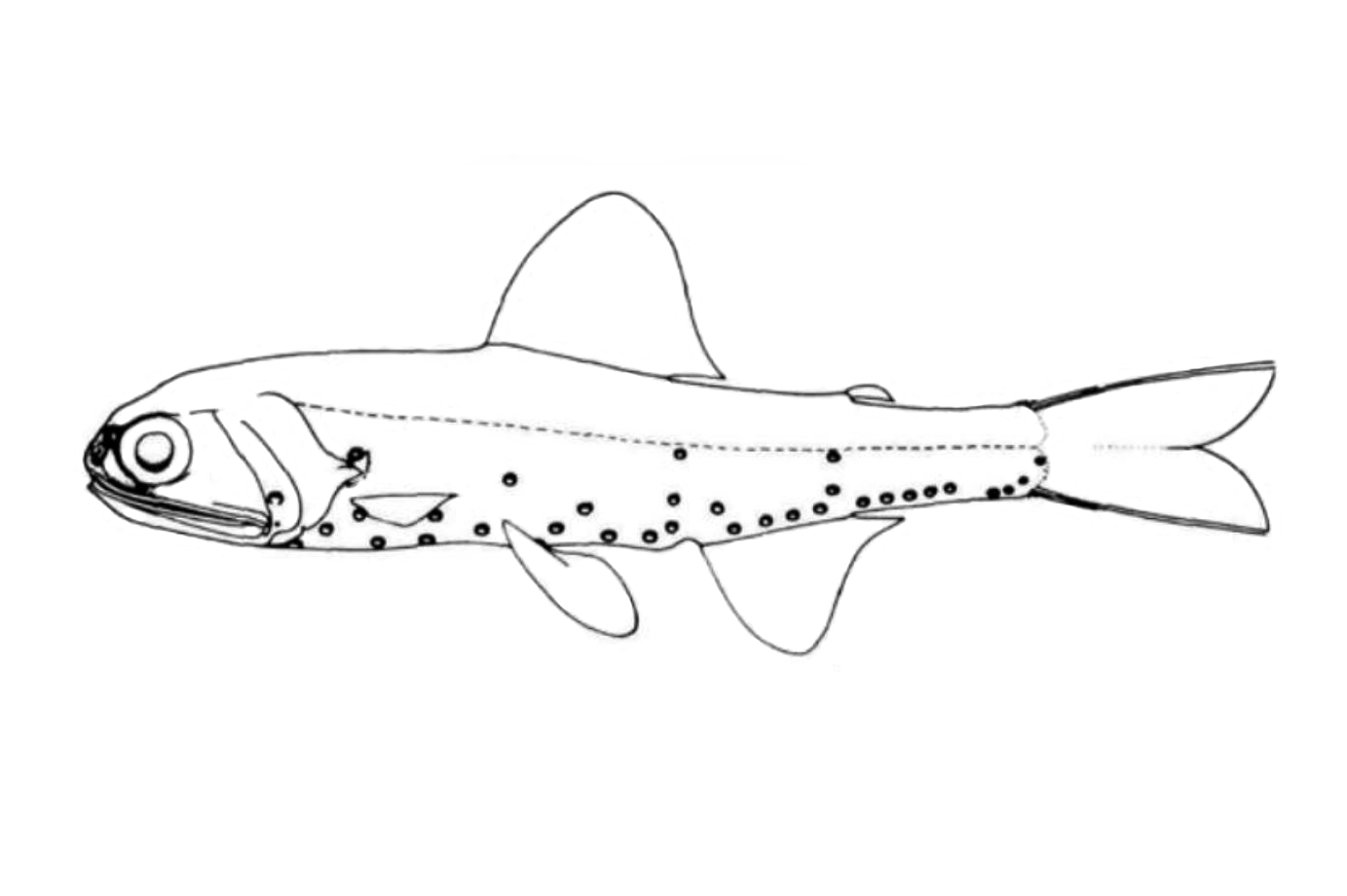Kapala Lanternfish, Diaphus kapalae Nafpaktitis, Robertson & Paxton 1995

Illustration of a female Kapala Lanternfish, Diaphus kapalae. Source: After Fig. 5, in Nafpaktitis et al. (1995) New Zealand Journal of Marine and Freshwater Research 29(3): 335-344. License: All rights reserved
Cite this page as:
Bray, D.J. 2022, Diaphus kapalae in Fishes of Australia, accessed 20 Apr 2024, https://fishesofaustralia.net.au/home/species/1451
Kapala Lanternfish, Diaphus kapalae Nafpaktitis, Robertson & Paxton 1995
More Info
|
Distribution |
NE of Hinchinbrook Island, Queensland, to the Great Australian Bight, E of Point Dempster, Western Australia, including Tasmania; also the Lord Howe Province and the Norfolk Island region in the Tasman Sea. Elsewhere the species occurs off New Caledonia, New Zealand, the Solomon Islands and Vanuata. Undertakes daily vertical migrations to feed at night in shallower waters, including surface waters. |
|
Etymology |
The species is named after the N.S.W. Fisheries FRV Kapala that collected numerous specimens off the coast of New South Wales. |
|
Species Citation |
Diaphus kapalae Nafpaktitis, Robertson & Paxton 1995, New Zealand Journal of Marine and Freshwater Research 29(3): 342, fig. 5. Type locality: Southeast of Sydney, 34°11'S, 151°29'E, New South Wales, Australia, Kapala station 77-02-02, depth 0-290 m. |
|
Author |
Bray, D.J. 2022 |
|
Resources |
Kapala Lanternfish, Diaphus kapalae Nafpaktitis, Robertson & Paxton 1995
References
Allen, G.R., Hoese, D.F., Paxton, J.R., Randall, J.E., Russell, B.C., Starck, W.A., Talbot, F.H. & Whitley, G.P. 1976. Annotated checklist of the fishes of Lord Howe Island. Records of the Australian Museum 30(15): 365-454 figs 1-2 (as Diaphus sp.)
Brandt, S.B. 1981: Effects of a warm-core eddy on fish distributions in the Tasman Sea off east Australia. Marine Ecology Progress Series 6: 19-33 (as Diaphus sp. nov.)
Catul, V., Ganus, M. and Karuppasamy, P. 2011. A review on mesopelagic fishes belonging to family Myctophidae. Reviews in Fish Biology and Fisheries 21(3): 339-354.
Flynn, A., Kloser, R.J. & Sutton, C.. 2018. Micronekton assemblages and bioregional setting of the Great Australian Bight: A temperate northern boundary current system. Deep Sea Research Part II: Topical Studies in Oceanography: 157-158. https://doi.org/10.1016/j.dsr2.2018.08.006
Flynn, A. & Pogonoski, J.J. 2012. Guide to Mesopelagic Fishes of the Southern Tasman Sea. CSIRO Marine & Atmospheric Research, 16 pp. https://doi.org/10.4225/08/584af4b007924
Gill, A.C. & Reader, S.E. 1992. Fishes. pp. 90-93, 193-228 in Hutchings, P. (ed.) Reef Biology. A Survey of Elizabeth and Middleton Reefs, South Pacific. Canberra : Australian National Parks Vol. 3, Kowari 230 pp. (as Diaphus sp. nov.)
Nafpaktitis, B.G., Robertson, D.A. & Paxton, J.R. 1995. Four new species of the lanternfish genus Diaphus (Myctophidae) from the Indo‐Pacific, New Zealand Journal of Marine and Freshwater Research 29(3): 335-344, https://doi.org/10.1080/00288330.1995.9516668
Rissik, D. & Suthers, I.M. 2000. Enhanced feeding by pelagic juvenile myctophid fishes within a region of island-induced flow disturbance in the Coral Sea. Marine Ecology Progress Series 203: 263-273https://doi.org/10.3354/meps203263
Suthers, I.M. 1996. Spatial Variability of Recent Otolith Growth and RNA Indices in Pelagic Juvenile Diaphus kapalae (Myctophidae): an Effect of Flow Disturbance near an Island? Marine and Freshwater Research 47: 273-282. https://doi.org/10.1071/MF9960273
Robertson, D.A. & Clements, K.D. 2015. 89 Family Myctophidae. pp. 613-680 in Roberts, C.D., Stewart, A.L. & Struthers, C.D. (eds). The Fishes of New Zealand. Wellington : Te Papa Press Vol. 3 pp. 577-1152.
Whitley, G.P. 1933: Studies in ichthyology No. 7. Records of the Australian Museum 79(1): 60- 112 https://doi.org/10.3853/j.0067-1975.19.1933.691 (as Collettia perspicillata)
Williams, A. 2019. Diaphus kapalae. The IUCN Red List of Threatened Species 2019: e.T130275173A130414115. https://dx.doi.org/10.2305/IUCN.UK.2019-2.RLTS.T130275173A130414115.en. Accessed on 09 July 2022.



